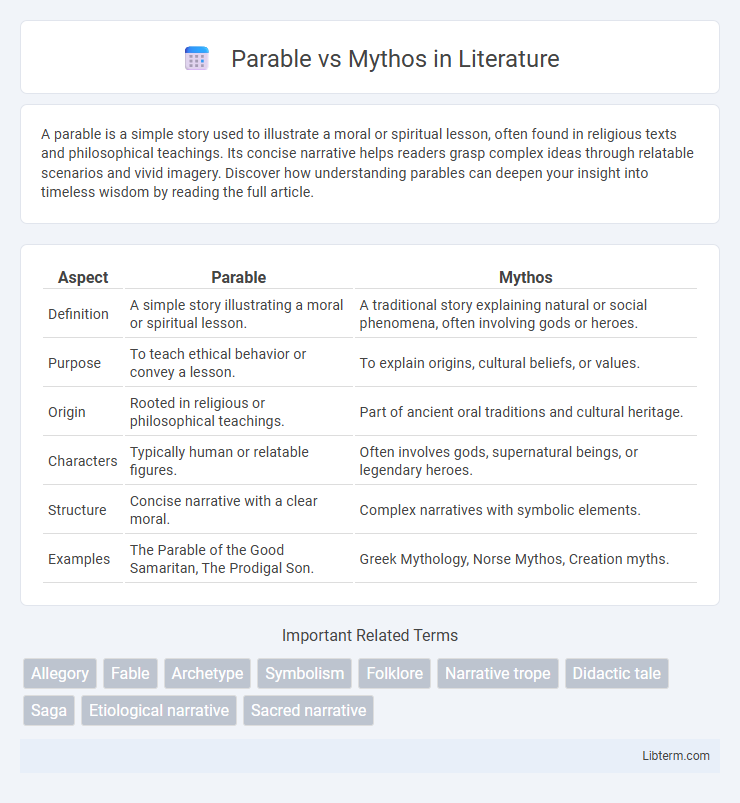A parable is a simple story used to illustrate a moral or spiritual lesson, often found in religious texts and philosophical teachings. Its concise narrative helps readers grasp complex ideas through relatable scenarios and vivid imagery. Discover how understanding parables can deepen your insight into timeless wisdom by reading the full article.
Table of Comparison
| Aspect | Parable | Mythos |
|---|---|---|
| Definition | A simple story illustrating a moral or spiritual lesson. | A traditional story explaining natural or social phenomena, often involving gods or heroes. |
| Purpose | To teach ethical behavior or convey a lesson. | To explain origins, cultural beliefs, or values. |
| Origin | Rooted in religious or philosophical teachings. | Part of ancient oral traditions and cultural heritage. |
| Characters | Typically human or relatable figures. | Often involves gods, supernatural beings, or legendary heroes. |
| Structure | Concise narrative with a clear moral. | Complex narratives with symbolic elements. |
| Examples | The Parable of the Good Samaritan, The Prodigal Son. | Greek Mythology, Norse Mythos, Creation myths. |
Introduction to Parable and Mythos
Parables are succinct, instructive stories that convey moral or spiritual lessons through relatable scenarios, often rooted in religious or philosophical contexts. Mythos refers to the foundational narratives or myths that shape cultural beliefs, traditions, and worldviews, embedding symbolic meanings within complex story frameworks. Understanding parable emphasizes its role as a didactic tool, whereas mythos underscores the significance of collective cultural identity through mythic storytelling.
Defining Parable: Key Characteristics
A parable is a succinct, didactic narrative that uses simple, relatable scenarios to convey moral or spiritual lessons. It typically features human characters and realistic settings, aiming to provoke reflection and ethical insight without relying on supernatural elements. Parables emphasize clarity and practical wisdom, distinguishing them from mythos, which often involve complex mythological frameworks and divine beings.
Understanding Mythos: Core Elements
Mythos centers on foundational narratives that express the collective values, origins, and worldview of a culture through symbolic storytelling. Key elements include archetypal characters, divine or supernatural themes, and moral or existential lessons conveyed through allegory and metaphor. These core components shape mythos as a framework for explaining human experience beyond literal interpretation.
Historical Origins of Parables
Parables trace back to ancient oral traditions, especially prominent in Jewish and Greco-Roman cultures where they served as moral and spiritual teaching tools. These simple, allegorical stories aimed to convey ethical principles and divine truths through relatable everyday scenarios, distinguishing them from mythos, which are larger, symbolic narratives explaining origins and cosmology. The historical origins of parables highlight their function as pedagogical devices designed to provoke reflection and internalization of core values within communities.
Origins and Evolution of Mythos
Mythos originated in ancient oral traditions, serving as a foundational framework to explain natural phenomena, cultural practices, and human experiences through symbolic stories and deities. The evolution of mythos reflects shifts in societal values, incorporating historical events, religious beliefs, and moral teachings to reinforce communal identity and worldview. Unlike parables, which are concise moral lessons, mythos encompasses a broader narrative complexity that shapes collective mythology and cultural heritage.
Narrative Structure: Parable vs Mythos
Parables feature a concise, straightforward narrative structure designed to convey a clear moral or lesson through relatable characters and situations. Mythos, on the other hand, employs complex, multi-layered storytelling that weaves symbolic themes, cultural archetypes, and divine elements to explain natural phenomena or societal values. The structural brevity of parables contrasts with the expansive and often cyclical nature of mythic narratives, reflecting their differing purposes in teaching and cultural preservation.
Purpose and Function in Society
Parables serve as concise, didactic stories designed to convey moral or spiritual lessons, often rooted in religious or ethical teachings that guide individual behavior and decision-making. Mythos encompasses broader cultural narratives that explain the origins, values, and worldview of a society, reinforcing social cohesion and collective identity through symbolic storytelling. Both function as essential tools for transmitting cultural knowledge, but parables focus on practical lessons while mythos establishes foundational myths that shape societal norms.
Examples of Famous Parables
Famous parables like the Prodigal Son from the Bible and Aesop's The Tortoise and the Hare illustrate moral lessons through simple storytelling. Unlike mythos, which often involve gods and creation myths such as the Greek myth of Zeus or the Norse Yggdrasil, parables focus on human behavior and ethical guidance. These narrative distinctions emphasize parables' role in teaching practical wisdom in various religious and cultural contexts.
Notable Mythos in World Cultures
Notable mythos in world cultures include Greek mythology with its pantheon of gods like Zeus and Athena, Norse mythology featuring Odin and Thor, and Hindu mythology rich with deities such as Vishnu and Shiva. These mythoi serve as foundational narratives explaining natural phenomena, human behavior, and cultural values, often passed through oral and written traditions. Unlike parables, which are short illustrative stories with moral lessons, mythos encompass broader cosmological frameworks integral to collective identity and religious practice.
Comparing Impact: Parable versus Mythos
Parables offer concise, relatable narratives that impart moral lessons through everyday scenarios, making their impact immediate and personal. Mythos, rooted in cultural and historical contexts, provides expansive stories that shape collective identity and societal values over generations. The impact of parables is typically individual and instructional, while mythos influences broader cultural cohesion and worldview formation.
Parable Infographic

 libterm.com
libterm.com